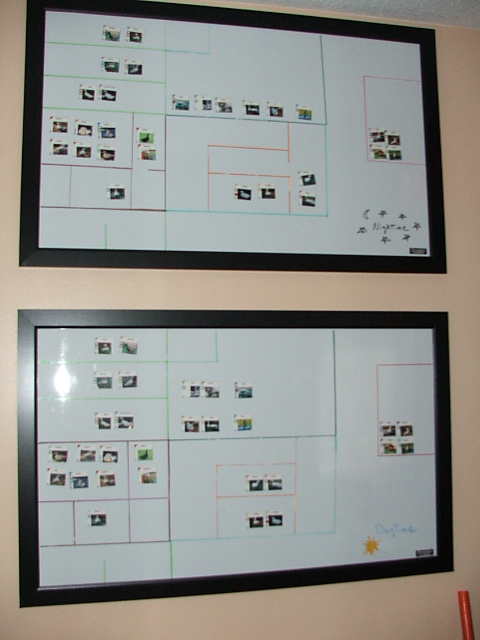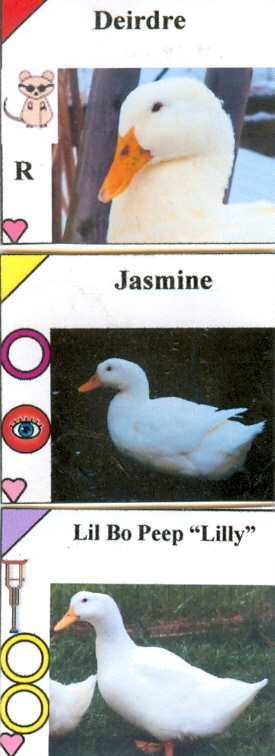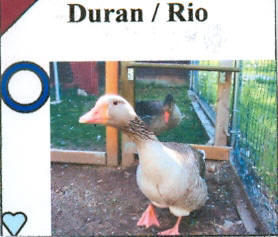Starting Your Own Sanctuary
There's a lot to consider before opening your own
waterfowl sanctuary. We literally opened overnight when
we discovered a number of ducks in need of sanctuary and
then spent a good year catching up to ourselves. It was
a 7 day a week job that took place 365 days a year--in
addition to our full-time jobs and parenthood.
Today things are quite a bit easier. We've learned to
design better pens that are more fully functional. We
know how to better pace ourselves and we understand our
own limitations.
For those of you who've asked for it, here's a bit of
advice about opening up your own sanctuary.
Pens
The first thing you will need is a safe and predator
proof pen for your rescued waterfowl. Our suggestion is
to start small--that is, begin with no more than 4 ducks
and then expand and build more pens as you grow.
The reason for this is simple, you will quickly learn
what works in your set-up and what doesn't. This
information will help you to design more efficient pens
in the future.
Starting out with only a few ducks will also keep you
from taking on too much too fast. You want to build up
to what you can handle, not overwhelm yourself right
from the get-go.
Consider seasonal changes as well as landscaping when
designing your pens:
Do you need special "trip" outlets for heated water
buckets during cold weather?
Will the grounds you choose be able to handle heavy rain
and allow for drainage?
Is there ample shade to help keep your rescues cool in
summer?
Are there dangerous tree limbs looming over the site of
your pens that could fall and cause damage or injury?
Have dangerous chemicals ever been dispersed in the
place where you want to build?
Time
Taking care of rescued waterfowl takes time. We spend an
hour a day in the morning and again in the evening just
with the day-to-day tasks. In addition to this are trips
to the vet, disbursement of medications, pen maintenance
and so on...
In the heat of summer water sources need to be kept
cool. This means kiddy pools & water buckets will need
to be changed frequently.
In winter special attention needs to be given to snow
and ice. Shoveling and sanding pens as well as keeping
aviary nets clear during storms is hard work and can
take an entire day.
Consider your vacation day options at work. Do you have
emergency time at your disposal for vet visits and snow
days?
What about family vacations? Who will RESPONSIBLY watch
your rescues while you are away? We resort to separate
vacations to ensure that a knowledgeable and experienced
caretaker is ALWAYS on our premises and ready for any
emergency.
Veterinary Care
Finding a qualified, experienced and compassionate vet
is one of your highest priorities and this most be done
BEFORE you begin rescuing.
You also need to find a 24/7 back-up vet for times when
your regular vet is unavailable or off-duty.
Your vet will also need to write you a letter if you are
interested in listing your shelter on Petfinder (which
we highly recommend if you will be adopting out your
rescues). Petfinder's staff will provide you with
detailed information after you contact them via their
website.
Funding
Finding funding for your sanctuary is another of the
most important things you will be doing. You need
donations to provide for feed, hay, supplies, building
materials, utilities and vet care (at the very least).
Having your own website helps in this regard, but you
also need to know other ways to generate funds.
Unless you are a professional grant-writer or have
similar experience & connections, not many organizations
are open to approving grants to waterfowl shelters
simply because they honestly don't understand the need
for them. Also, it takes a lot of time to organize grant
proposals, and in our experience, we have been more
successful at raising the funds ourselves.
Standard Procedures
We have a handful of procedures at Majestic. We have
adoption procedures that flow from the initial
application to the signing of contracts on adoption day.
We have volunteer procedures that flow from applications
to liability waivers onto actual work days. In addition,
we also have operating and emergency procedures.
Here is an example of our quarantine procedure:
Newly rescued ducks and geese are placed into our
quarantine pen immediately upon arriving.
We created our own medical form that
enables us to perform an immediate, standard precursory
exam of every bird who comes through our sanctuary. If
we discover any ailments/conditions that require vet
care, we arrange for an immediate appointment.
A fecal sample is brought to our vet for lab testing to
rule out parasites. A precautionary
worming and delousing is also performed to prevent
parasites from invading our flock. The
newcomer is given an original name and an
identifying leg band, which are charted in their medical
files and on a magnetic wipe away board.
The new rescue remains in quarantine for
a minimum of 14 days to ensure they are in
excellent health.
A magnetic wipe away board is used to
indicate where each duck and goose is located in the
sanctuary during the day and another indicates what
pen/barn they are located in at night. This also doubles
as our emergency back-up plan, which means in our
absence, anyone could come in and be able to tell which
birds are in which pens.

Small magnets are loaded with information. They tell us
the bird's name, gender, leg band color, special needs
and which birds need to be adopted out together. Here
are a few examples:

Deirdre does not wear a leg band. Deirdre
is blind in her Right eye
She is a female duck (pink heart).
All ducks with a red corner are original
sanctuary members and are unadoptable.
Jasmine has one pink leg band. She is a
female (pink heart).
All ducks with a yellow corner must be
adopted out together. Jasmine has one
injured eye. Lilly
has two yellow leg bands. She is a female
(pink heart).
All ducks with a lavender corner must be
adopted out together. The crutch
indicates a leg injury or limp. (Once she
recovered, we changed out the magnet with one that did
not feature a crutch.)

Duran "Rio" has one blue leg band. He is
a male (blue heart). All geese with a
rust corner must be adopted out together.
In addition to these magnet boards, we have one other
that indicates detailed daily/weekly medical regimes for
ducks and geese with special needs.
Emergency Back-up Plan
Have an emergency plan in place. What is an emergency
plan? It can range from what to do in a power outage to
what to do if you can't make it home one night. Make
sure a well-versed person can come in at any time and
know exactly what to do.
They should be able to:
Easily perform all day-to-day tasks.
Determine which bird is which in any given pen.
Administer any medications at the appropriate times to
the correct birds. These are just
a few of the types of considerations that should be a
part of your emergency back-up plan.
A few tips:
Volunteer at a local animal shelter before opening your
own. Try to find a shelter that is as similar as
possible to the kind of shelter you would like to open
for practical experience and foreknowledge about the
kinds of issues that tend to come up.
After opening, reach out to other shelters like your own
and find ways to work together. Can you help find each
other potential adopters? Maybe organize a dual
fundraiser? Discover new ways to educate the public?
Start small (with no more than 4 birds in your shelter
at any one time) and keep it small for at least one
year, so you can see how the seasons affect your pen.
Figure out what works and what doesn't before
expanding and building new pens. Starting small will
also enable you to envision how much time and effort
will be required for additional rescues. Time management
is an essential part of sanctuary life.
Don't overwhelm yourself by taking on more than you can
handle. Give yourself time to decide if this endeavor is
really for you before you expand your efforts.
Design your pens to be both
functional and attractive to meet your
needs, the needs of your rescues and the
aesthetics of your potential adopters. This
includes keeping your pens clean & tidy!
Having a great relationship with your veterinarian &
staff means everything to your sanctuary. Foster a
professional and friendly relationship and it will
directly benefit your rescued ducks and geese. This
means treating everyone in their office (including
their other clients) with respect and kindness,
showing up on time for all of your appointments and
paying your bill in full at the time of service.
Don't rely on anyone else to get the job
done. Always have your back-up plan ready and be
prepared to do everything yourself. Although people
often have good intentions, you will soon discover that
you and your rescues can't rely on good intentions
alone. Be entirely self-reliant so these instances won't
negatively impact you or your sanctuary.
Understand from the get-go that you are
not going to be able to help every animal out
there who needs you. If you don't make peace with this
notion from the very start, your emotional health will
soon suffer. Instead, find peace in helping those
animals you can.
Rescuing takes a great deal of emotional
strength. Be prepared to deter any guilt trips, threats
or unfounded criticisms when it comes to your inability
to take in a particular animal from someone. Also
prepare yourself for the advice they are about to give
you on how you should be running your shelter.
Maintain your composure and point them towards other
alternatives for the animal whenever possible, but
ultimately, don't internalize any of what they are
saying. It's not your fault. A
good supportive friend or family member to lean on is an
absolute must in rescue work. Be
patient and kind when pets are being surrendered to you.
No matter how irresponsible or unreasonable the owner
is, you're only chance of educating them is if they like
you enough to want to listen. Bite your tongue, let them
talk, make gentle corrections if necessary and always
smile while you talk. After they leave, call a friend
for a good vent and some emotional support. Remember, if
they leave your shelter feeling positive about the
experience, they may talk about it to others. Donations
will find their way to you in a number of ways.
Word of mouth is everything. Maintain an
impeccable reputation. Take full responsibility for your
animals. This can be as simple as accepting an animal
back from an adopter without a guilt trip if
things don't work out or as complicated as helping an
animal who becomes unexpectedly ill immediately after
their adoption. Whatever the situation is, work towards
a quick and friendly resolution for the sake of
everyone's well-being, especially the animal's.
Never take on more than you or your other rescued
animals can handle. This means learning to say, "No."
You need to be able to properly provide for all of your
animals at any given time while ensuring that any
newcomers will not overcrowd, overstress or negatively
impact any of the rescued birds already in your care.
Take time to enjoy what you're doing. Handling
situations with jeopardized animals can be extremely
difficult and emotionally taxing, but don't let things
get you down. Take some time each day to visit with your
rescues and enjoy their company. They are your
inspiration, so keeping them in sight is vital to your
endeavor. Let them help you keep focused and they will
reassure you that you are doing all that you can and
that you're dedication is not going unnoticed.
Know when to quit. If you discover that you don't have
what it takes to go on any longer, plan out a good place
to stop. Shelter work is not for everyone and it's a lot
harder than it sounds. If you burn yourself out, you
won't be providing the high quality care that your
rescues deserve. Stop taking in new animals and continue
working on finding good homes for the ones you already
have. When this is done you can close your doors and
feel good about the work you've done.
Establishing Non-Profit Status
We are often asked detailed questions about how to
obtain official 501(c)(3) non-profit status, but we did
not do this ourselves.
Originally, I called numerous law offices asking for
pro-bono help in this regard. Whenever they turned me
down, I asked for a referral and I kept on calling. When
this ultimately failed, I began putting the word out for
help on our website, in our brochures and in newspaper
coverage of our sanctuary.
Putting the word out that we needed legal assistance
opened the door for help finding us. We were very
fortunate to be discovered by both a skilled attorney
and a certified accountant to help us establish our
non-profit status.
Becoming an official non-profit organization was quite
an involved process and although some people may advise
you to do it entirely on your own, we advise some solid
professional help.
Majestic Waterfowl
Sanctuary makes no representation, warranty, or guarantee in
connection with any guidance provided on this website. Majestic
Waterfowl Sanctuary expressly disclaims any liability or
responsibility for loss or damage resulting from its use or for
the violation of any federal, state or municipal law or
regulation with which such guidance may conflict. Any guidance
is general in nature. In addition, the assistance of a qualified
professional should be enlisted to address any specific
circumstances.
© Majestic
Waterfowl Sanctuary 2010 |

